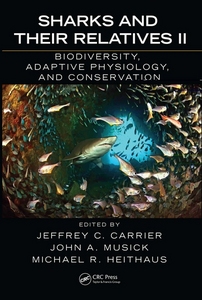Deepwater Chondrichthyans
Kyne, Peter M., and Simpfendorfer, Colin A. (2010) Deepwater Chondrichthyans. In: Carrier, Jeffery C., Musick, John A., and Heithaus, Michael R., (eds.) Sharks and their Relatives II: Biodiversity, Adaptive Physiology, and Conservation. CRC Marine Biology Series . CRC Press, Taylor and Francis Group, Boca Raton, Florida, USA, pp. 37-113.
![[img]](https://researchonline.jcu.edu.au/15303/4.hassmallThumbnailVersion/15303_Kyne_%26_Simpendorfer_2010_Book_Cover.jpg)
|
Image (JPEG) (Book Cover)
- Cover Image
Download (181kB) |
|
|
PDF (Published Version)
- Published Version
Restricted to Repository staff only |
Abstract
The deep sea is a relatively stable environment, characterized by cold temperatures and poor or absent light. Relative to inshore shelf habitats, the ocean's deepwater environments remain poorly known. The continued expansion of global fishing into the deep ocean has raised new concerns about the ability of deepwater organisms to sustain the pressures of exploitation (Morato et al. 2006). General knowledge on the deep sea lags behind the expansion of fisheries (Haedrich, Merrett, and O'Dea 2001) and as such management is often further behind. The intrinsic vulnerability of the chondrichthyan fishes given their life history characteristics (Hoenig and Gruber 1990; Cahmi et a1. 1998; Musick 1999) is widely acknowledged and often cited. This vulnerability may be heightened in the deep sea, where conditions result in slower growth rates and reduced recruitment to populations. The vast majority of available life history data on the sharks, batoids, and chimaeras comes from the shallow water. Logistical, biological, and geographical difficulties with sampling (i.e., scattered distributions, deep occurrence, taxonomic uncertainty, and limited material) in the deep sea have limited the present state of knowledge. The amount of available information has, however, increased in recent years, and demonstrates that deepwater species are among the most unproductive of the chondrichthyans.
Here we review the present state of knowledge concerning this diverse group of chondrichthyans, which represents some 46% of the global shark, ray, and chimaera fauna. We focus mainly on their life history, the essential information required to effectively direct management. We define the deep sea to be that region of the ocean that lies beyond the 200 m isobath, the depth generally recognized as the continental and insular shelf edge (Merrett and Haedrich 1997). Hence, deepwater chondrichthyans are those sharks, rays, and holocephalans whose distribution is confined to (or predominantly at) depths below 200 m, or those that spend a considerable part of their lifecycle below this depth. This encompasses the continental and insular slopes and beyond, including the abyssal plains and oceanic seamounts. In the broadest sense, the deepwater fauna can be divided into pelagic species that occupy the water column and demersal species that occur on (benthic) or just above (epibenthic or benthopelagic) the ocean floor (Haedrich 1996). We discuss both of these groups, although the demersal species feature more prominently. With regards to the pelagic fauna we have limited our discussion of those species that occur in the mesopelagic (200 to 1000 m) and bathypelagic (1000 to 4000 m) zones if they also readily occupy the epipelagic (0 to 200 m) zone. Epipelagic species are treated in Chapter 1.
Excluded from our discussion are many chondrichthyans that have been recorded at depths of >200 m but that are predominantly species of the shelf. These species are recorded far less commonly or irregularly in the deep sea and include such examples as spiny dogfish Squallis acanthias (recorded exceptionally to 1446 m) and many skates whose distribution extends to the upper slope (including sandy skate Leucoraja circularis, blonde skate Raja brachyura, thornback skate R. clavata, clearnose skate R. eglanteria, brown skate R. miraletus, and rough skate R. radula). Other species that are abundant on the shelf in parts of their range are included here if they are also widely occurring on the slope. Examples include shortnose spurdog Squalus megalops, longnose skate R. rhina, big skate R. binoculata, barndoor skate Dipturus laevis, and spotted ratfish Hydrolagus colliei, and for these species, much of the available information on life history comes from the shelf (where the species may be subject to strong seasonal light and temperature signals).
| Item ID: | 15303 |
|---|---|
| Item Type: | Book Chapter (Research - B1) |
| ISBN: | 978-1-4200-8047-6 |
| Date Deposited: | 03 May 2011 06:16 |
| FoR Codes: | 07 AGRICULTURAL AND VETERINARY SCIENCES > 0704 Fisheries Sciences > 070402 Aquatic Ecosystem Studies and Stock Assessment @ 100% |
| SEO Codes: | 83 ANIMAL PRODUCTION AND ANIMAL PRIMARY PRODUCTS > 8302 Fisheries - Wild Caught > 830204 Wild Caught Fin Fish (excl. Tuna) @ 100% |
| Downloads: |
Total: 209 Last 12 Months: 4 |
| More Statistics |



